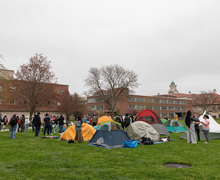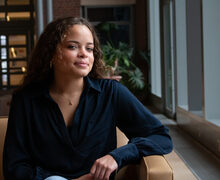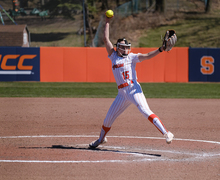International students from China experience art education differently in the U.S.
Katie Marcy | Daily Orange File Graphic
Our columnist argues that compared to the Chinese expectations of art education, the American system emphasizes much needed creativity and value.
Get the latest Syracuse news delivered right to your inbox.
Subscribe to our newsletter here.
Editor’s Note: Four years ago, The Daily Orange Opinion section launched a collaboration with SU’s WeMedia Lab. The project, “International Voice,” was dedicated to sharing the perspectives of international students using WeMedia Lab’s WeChat platform to translate articles. Now, The D.O. is re-introducing the project in the hopes of creating a space for more international voices.
Why do I find it harder to come up with my own creative ideas?
When it comes to recalling the art education that I experienced in China, I feel a huge difference from the teaching style at Syracuse University that I observed. Not to mention, I was in an international school, which already lies away from the ordinary art education in China. Experiencing that style of art education truly would have led me to tears.
“I think it can be incredibly challenging and confusing and disorienting for those students who’ve never experienced this expectation of creativity,” said Sarah Long, an SU professor who teaches CAR137: Introductory Computer Art, about the differences between an American and Chinese art education.
Upon hearing her response, I paused for a moment of reflection, suddenly not feeling surprised. A few days later, while discussing topics of creativity and art, I had a deeper conversation with Long, leading to further reflections from my individuality to a bigger picture.
In my experience, the creative process follows a strict set of steps, being outlined in the syllabus and emphasized by the instructor on a daily basis.
Our instructor would evaluate whether each person’s sketchbook demonstrates experimentations, practices and reflections, which are three grading criteria for the AP 2D design exam. Gradually, I noticed some of my international school classmates brainstorming and experimenting just for the sake of doing so, and creating artwork before conceiving ideas.
Such an approach has the most obvious metric that helps students to align with the “sustain investigation” requirement of the subject. Meanwhile, the polished and “well-supported” ideas can help them earn scores in AP exams that are credible to exchange college credits.
I began to think differently about this approach after taking CAR131 at SU. In class, Long brought a different attitude toward the idea development: there were no prompts for the assignments that encouraged students to think of anything.
“Every student is different, and the creative process is also different,” Long said, “I don’t dictate the creative process, such as using sketchbooks. If the process doesn’t suit them, the students won’t put in their best efforts. My course focuses more on students’ exploration of their own creative process.”
I was shocked after hearing this and wondered how students can make great art without guidance in an introductory course. I pondered the reason why I struggled to generate ideas as she suggested that open-ended ideas are “challenging.”
I believe developing the ability to explore one's own path is essential in creative education and something we need to reflect on daily.Andy Bian, Columnist
Long’s teaching style reflects the environment of how American students’ creativity are nurtured, leading me to a further exploration about dealing with my “idea drought.”
For most Chinese students, it is undeniable that art education for creativity is marginalized. Such education mostly focuses on fine arts: color, sketching, drawing, large proportion, tone etc. In the meantime, most students study for “Yi Kao,” known for China’s college entrance examination for art majors. Students are tested based on their ability to draw more realistically and express textures and details in the way the rubric deems; if Vincent Van Gogh were to draw during the art exam, he would probably be fading into obscurity and mediocrity.
This phenomenon also conforms, from my perspective, to the influence of the utilitarianism of art on Chinese students. There is a mainstream stereotype about art study in China that one needs to be wealthy to study the subject. In addition to this many Chinese students may be deterred from pursuing art by their parents that don’t view an art degree as “valuable.”
“We’re not making (the fine art) for utilitarian purposes, but does that matter for the value of the piece or the object?” Long said. “I would say if anything, it increases the value of it. How much you’re going to pay for a cup to drink out of, it’s probably mass-produced. But if it’s more than just a cup to drink out of and its creative process goes beyond utilitarianism, it could become infinitely valuable.”
She used ceramics as an example during our conversation. In doing so, Long showed me how creativity can work with practicality and as a result inspire new ideas. These ideas made the piece priceless.
Long disregards the idea that art lacks practicality, pointing out that art education is an important factor to inspire creativity which is an indispensable part of human development. Creativity prevents us from being replaced by artificial intelligence and allows us to start the way in various fields, such as film and design.
Long also believes the digital era can still produce artists who can take advantage of technological advancements.
“With the internet and digital art and the computer, people stand a better chance than ever at becoming successful artists. Etsy and even Facebook, they create a venue for a lot of artists, not just visual artists, but also musical artists like musicians,” Long said.
Overall, while it seemed that I was struggling with the topic of the art class, in reality, I was struggling to break free from a common mindset: conformity. Humans prefer to live in their comfort zone with clarity, but in the increasingly fast-paced world of rapid iteration, everything is shrouded in mist. I believe developing the ability to explore one’s own path is essential in creative education and something we need to reflect on daily.
While understanding this pluralistic world, I still have a long way to go in exploring my insights and style as an international student. Whether an international student or domestic student, I encourage everyone to continue to reflect on your relationship with both creativity and conformity.
Andy Bian is a freshman majoring in Advertising. He can be reached at hebian@syr.edu.
Published on April 10, 2024 at 11:23 pm





